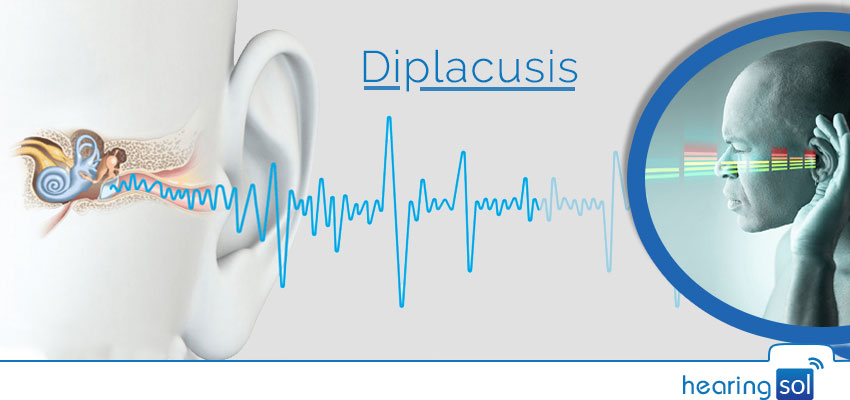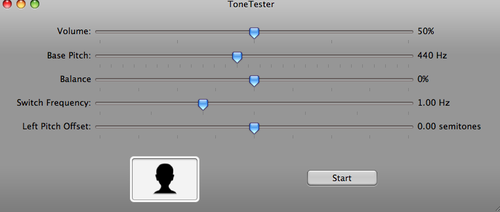
As you all are aware of the working mechanism of your auditory system. Your ears are complex and amazing organs. It collects the noises and sounds from various sources and processes them.
Afterward, it translates these processed noises into recognizable sounds. On the basis of that sounds, your brain makes decisions.
You can purchase the latest hearing aids at a fair price through HearingSol, If you need any assistance or you have a query regarding Diplacusis Binauralis (Double hearing)or Hearing Loss, feel free to call us at +91-9327901950. We are always here to help you.
Generally, your ears hear sounds at different pitches all the time. It is a surprising fact that you may start hearing sounds so different that it makes two sound experience.
This cause of hearing impairment is called as double hearing or Diplacusis.
What Is Diplacusis Or Double Hearing?
Diplacusis (pronounced dip-lah-KOO-sis), also known as diplacusis binauralis, “binauralis disharmonica“ or interaural pitch difference (IPD).
It comes from the Greek words “diplous” and “akousis” meaning double hearing. This is the most common type and a frustrating hearing condition.
It will occur when a person hears the same sound as two separate sounds differently in each ear that may differ in pitch, tone, or timing. Not exclusively, but it may be experienced as a secondary symptom of sensorineural hearing loss (SHL).
Although not all patients having sensorineural hearing loss will experience diplacusis or tinnitus.
According to a recent study published online in the U.S. National Library of Medicine National Institutes of Health, diplacusis is the “perceptual anomaly whereby the same sound is perceived as having a different pitch depending on whether it is presented in the left or the right ear.”
At any particular time, our ears hear a multitude of noises, and based on all that incoming information, our brain is making a lot of decisions.
Patients with sensorineural hearing loss may experience diplacusis or tinnitus. While hearing different pitches in each ear are common, which come in many forms.
There is a different form of diplacusis. It occurs when hearing loss experienced in one ear. Diplacusis is usually noticed after trauma, a severe ear infection, from taking certain medications.
Types of Diplacusis
According to research, in diplacusis people experience hearing of one sound as two sounds. Diplacusis occurs when one ear develops more hearing loss than the other. It is of four types such as –
Diplacusis Dysharmonica
You hear the correct pitch in one ear, while another ear hears at a different pitch i.e. incorrectly. Incorrect sound can be higher or lower pitch than the correct one. It occurs when sound is perceived in a normal way in one ear but is heard at a different pitch in the other.
Diplacusis Binauralis
It is the same as disharmonic. In this people hear the same sound at a different pitch in each ear. But the only difference is binaural refers to differences in timing. Means’ ear doesn’t hear the sounds from each ear at the same time. It is more frequent, and more pronounced, in people with hearing difficulty, especially, people with asymmetric hearing loss compared to people with normal hearing.
Diplacusis Echoica
It is an unusual form, the person will hear the same sound repeated like an echo in the same ear. You hear an echo sound of the original sound, which gives rise to the term double hearing.
It occurs when the timing of tones is slightly different from each other. It is the result of echo in left ear relief.
Diplacusis Monauralis
The ear hears the same sound as two sounds in the same ear. They may be different pitches or tones and variations in sound.
Well, diplacusis is the most troublesome and irritating hearing concern. You may suffer from the double hearing due to the various causes. Let’s study it in detail.
Diplacusis Causes
Diplacusis is a symptom of Unilateral or bilateral hearing loss. It results when people experience some hearing loss in one ear, or experience uneven hearing loss in both of your ears.
It is sudden and caused by excess noise, an ear infection, clogged sinuses, tumor, excess earwax, or head trauma.
People who develop diplacusis may also experience tinnitus, a ringing or buzzing noise in the affected ear. It is typically the result of a sensorineural hearing loss, but that is not always the case.
The diplacusis is caused when the ear is unable to transmit the message to the brain. It is so because of the blocked passageway.
If your ear will not function properly, you may experience more than one sound at a different pitch in your ear. Hearing loss is extremely common among musicians.
Diplacusis leads to the dissonance in the pitch or timing of a sound, so one ear often hears the correct tone, while the other detects the pitch as either flat (lower) or sharp (higher).
This type of hearing loss can be either temporary or permanent in nature. Whereas some other potential causes of hearing loss include:
- Ear infection
- Wax build-up
- Head trauma
- Damage to the inner ear
- Noise-induced-hearing-loss (NIHL)
- A number of other health conditions which impact upon hearing.
Thus the main causes of Diplacusis or double hearing are :
1. Conductive Hearing Loss
If you experience temporary Diplacusis due to an ear infection, a blockage in the ear (such as ear wax) or from foreign objects in the ear (like insects or dust and debris).
It can also be the result of a sinus infection, sinus headache, blocked sinuses, or clogged eustachian tubes.
In a conductive hearing loss, the diplacusis is caused when the ear is unable to transmit the message to the brain because the passageway is blocked or partially blocked.
Because your ears are not functioning properly, you may experience the perception of more than one sound or sound may be distorted.
2. Sensorineural Hearing Loss
Diplacusis can be the result of exposure to loud noises or trauma to the head that have caused permanent damage to the ear.
This sensorineural hearing loss may also occur due to health conditions that affect hearing or from medications used to treat other ailments. If this is the case, the diplacusis may be a permanent condition.
In case of temporary hearing loss, the Diplacusis is most likely to correct itself as soon as the hearing returns. Unfortunately, it can also cause permanent impairment.
Symptoms of Diplacusis
Each diplacusis type results in slightly different symptoms. These include:
- A person hearing the same sound like two different sounds, but in the same ear
- Sound repeated like an echo in the affected ear
- Hearing the sound at the correct pitch in one ear and at a different pitch in the other
- Hearing the same sound differently in each ear
Risk of Diplacusis
Diplacusis is a type of hearing impairment, which is very common among musicians. There is nothing to be surprised that musicians are at higher risk for Diplacusis as compared to the normal population.
Though unfortunate, they tend to notice pitch and tone differences more readily. This is what the average person does not notice. Therefore, they are more aware of potential pitch and tone differences.
Due to this, they even possess a higher risk when it comes to developing Diplacusis. Finding of diplacusis in case of hearing loss is a valuable diagnostic aid in localizing the pathologic condition.
In comparison to 1.5% of the general population, roughly 5% of musicians admitted experiencing a form of Diplacusis. The most effective way to lessen the risk of developing Diplacusis is by preventing noise-induced hearing loss (NIHL).
This involves careful management of noise exposure for prolonged periods of time, meanwhile taking precautions such as using earplugs when requires.
Diplacusis Test
Most of the musicians don’t recognize while playing the note B flat that while their right ear is detecting the B flat but their left ear instead of B flat, it recognizes it closer to B natural.
Therefore, the semitone difference is detected between the two ears in the case of diplacusis.
According to health professionals, the difference in intensity or volume of pitch over a long period of time can cause hearing difficulty in the future.
According to research published in NCBI, a randomized maximum sequential procedure was developed, to test the relationship between the pitch sensation between the two ears as a matched frequency range.
This improved pitch- matching test is used to judge the characteristics of diplacusis in people with hearing loss as well as in people with normal hearing.
In diplacusis test most of the musician test their hearing using pitch detection testers, that is used to identify the fundamental frequency (f0), known as pitch. You can check also test your hearing using the Tone tester.

Tone tester uses simple sliders with which you can adjust the pitches played until the right and left ears to hear a similar sound. The tester tells you the difference in pitches in terms of a difference in a semitone.
It also helps in improving your hearing by recommending the different pitches. In some cases, the tone test also suggests consulting an audiologist to find the exact cause of hearing loss.
Diplacusis Treatment
Treatment for double hearing varies from case to case. The best way to cure would be treating the underlying hearing loss. If your diplacusis caused by an obstruction, it can be resolved once you remove the earwax or clean your ear infection.
While this hearing loss may be permanent and can possibly be treated with hearing aids or cochlear implants. This will be helpful in reducing the negative symptoms of diplacusis.
There may be some cases with no cure. Then the sufferer needs to develop an understanding regarding the condition. After this, seek therapy to help overcome the ongoing suffering.
Diplacusis echo treatment is also done by experts. This test involves various steps. It’s very important to diagnose the type of diplacusis so that the appropriate treatment can be applied.
So if you notice any symptom of double hearing, consult with your doctor or hearing healthcare professional for an appointment.
They can do a painless hearing test or go for a toner test. Depending on the result of your test consult a hearing specialist who will provide the right course of action.
You can purchase the latest hearing aids at a fair price through HearingSol, If you need any assistance or you have a query regarding Diplacusis Binauralis (Double hearing) or Hearing Loss, feel free to call us at +91-9327901950. We are always here to help you.
Read More :

 Reviewed by Mr. Ranjeet Kumar
Sr. Audiologist, Speech Therapist & Cochlear Implant Specialist, BASLP on
Reviewed by Mr. Ranjeet Kumar
Sr. Audiologist, Speech Therapist & Cochlear Implant Specialist, BASLP on